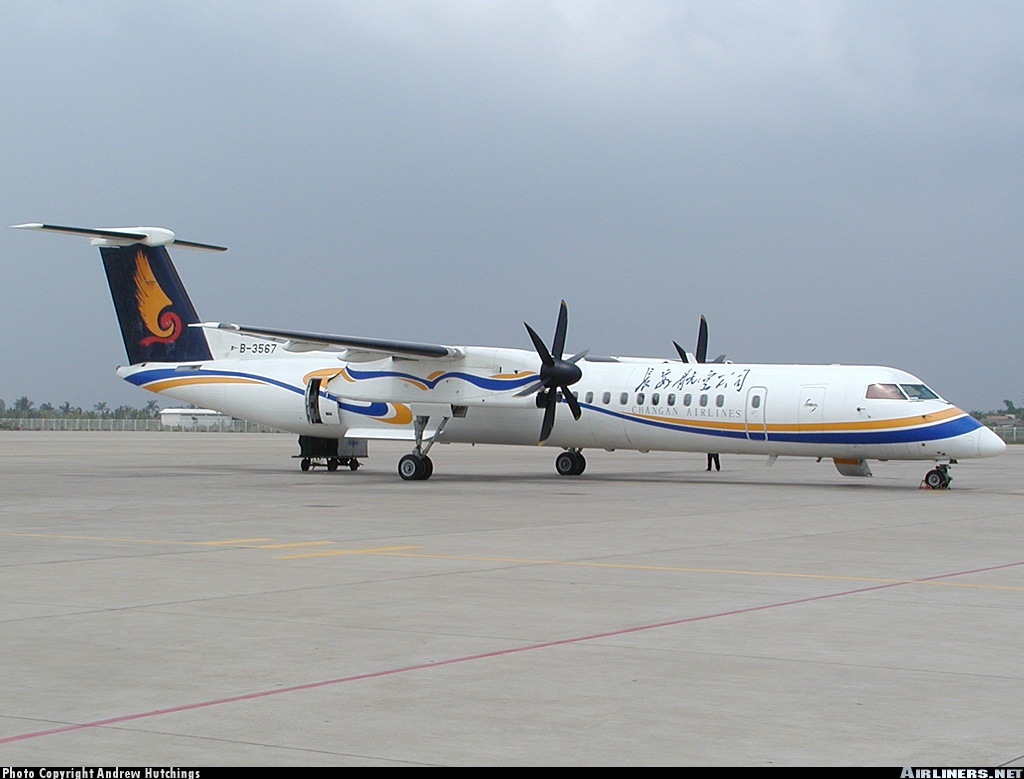Country
Crash of a De Havilland Dash-8-Q402 in Vilnius
Date & Time:
Sep 12, 2007 at 0136 LT
Registration:
LN-RDS
Survivors:
Yes
Schedule:
Copenhagen - Palanga
MSN:
4035
YOM:
2001
Flight number:
SK2748
Crew on board:
4
Crew fatalities:
Pax on board:
48
Pax fatalities:
Other fatalities:
Total fatalities:
0
Captain / Total hours on type:
291.00
Copilot / Total hours on type:
262
Aircraft flight hours:
11366
Aircraft flight cycles:
14224
Circumstances:
The aircraft departed Copenhagen-Kastrup AIrport on a flight to Palanga with 48 passengers and a crew of 4 on board. Following an uneventful flight, the crew started the descent. At an altitude of about 2,000 feet, the crew selected the landing gear down. However, the right-hand main gear extended but did not lock down and the landing gear doors did not close. The approach was abandoned and the crew initiated a go-around. During the second attempt to land, the crew recycled the system but the warning remained so the decision was taken to divert to Vilnius. On approach, the crew attempted to release the undercarriage using a backup system, but the undercarriage control panel still showed an unsafe warning. The right engine was shut down and the propeller was feathered prior to landing. Upon touchdown, the right main gear collapsed. The aircraft veered off runway and came to rest 40 metres further, some 1,150 metres pas the runway threshold. All 52 occupants evacuated safely and the aircraft was damaged beyond repair.
Probable cause:
The aircraft accident was caused by the separation of the piston rod of the extension/retraction actuator from the rod end during right hand main landing gear extension due to thread connection corrosion. The freely falling landing gear broke the apex hinge lugs of the stabilizer sections, the right hand landing gear did not lock in the extended position and collapse occurred when the aircraft was rolling after landing.
Final Report:


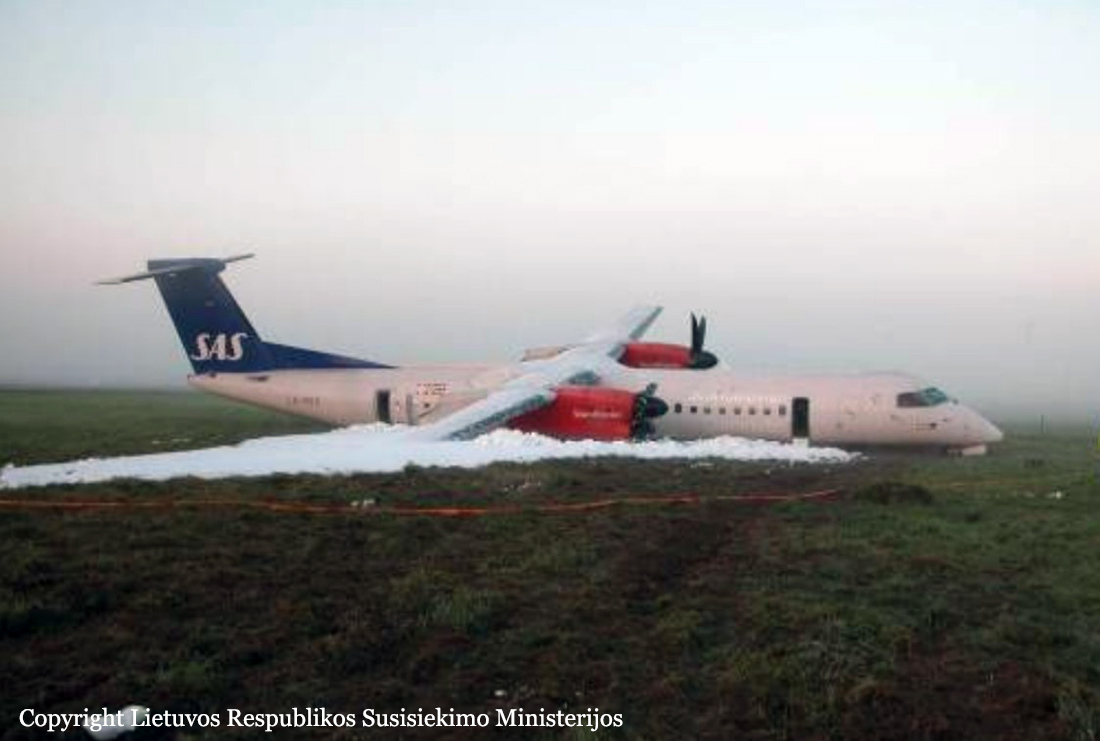
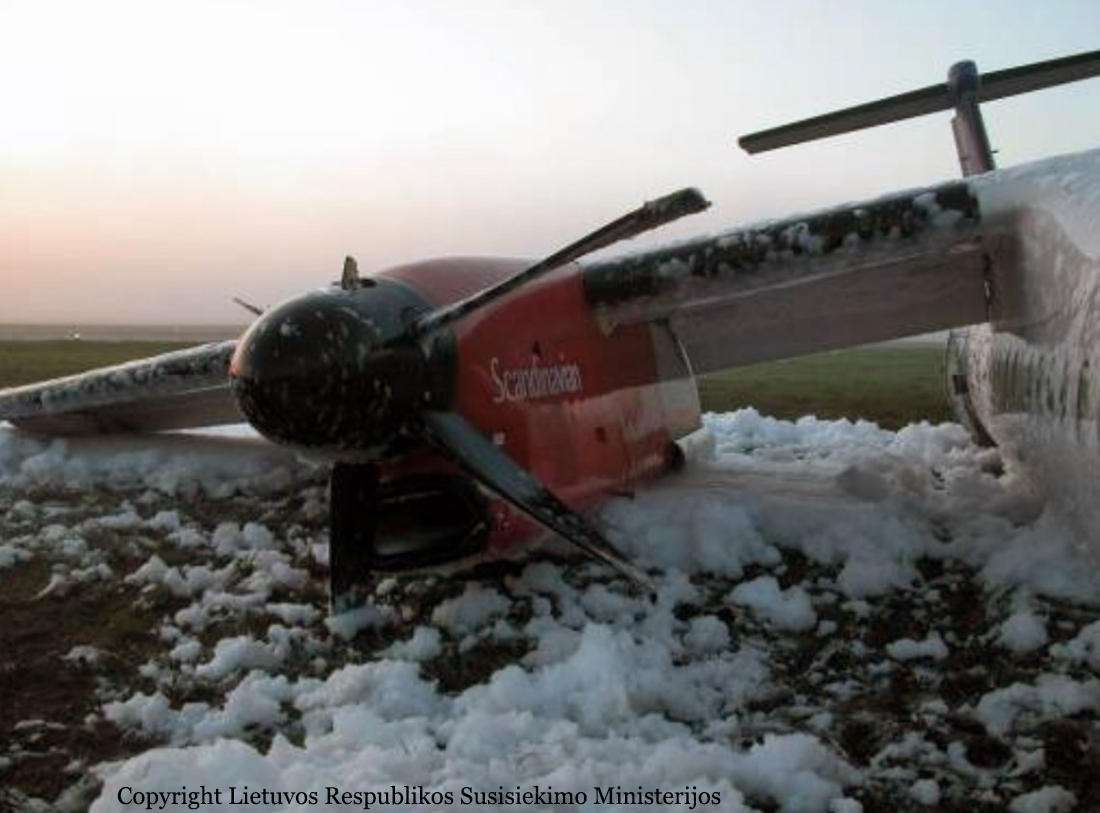

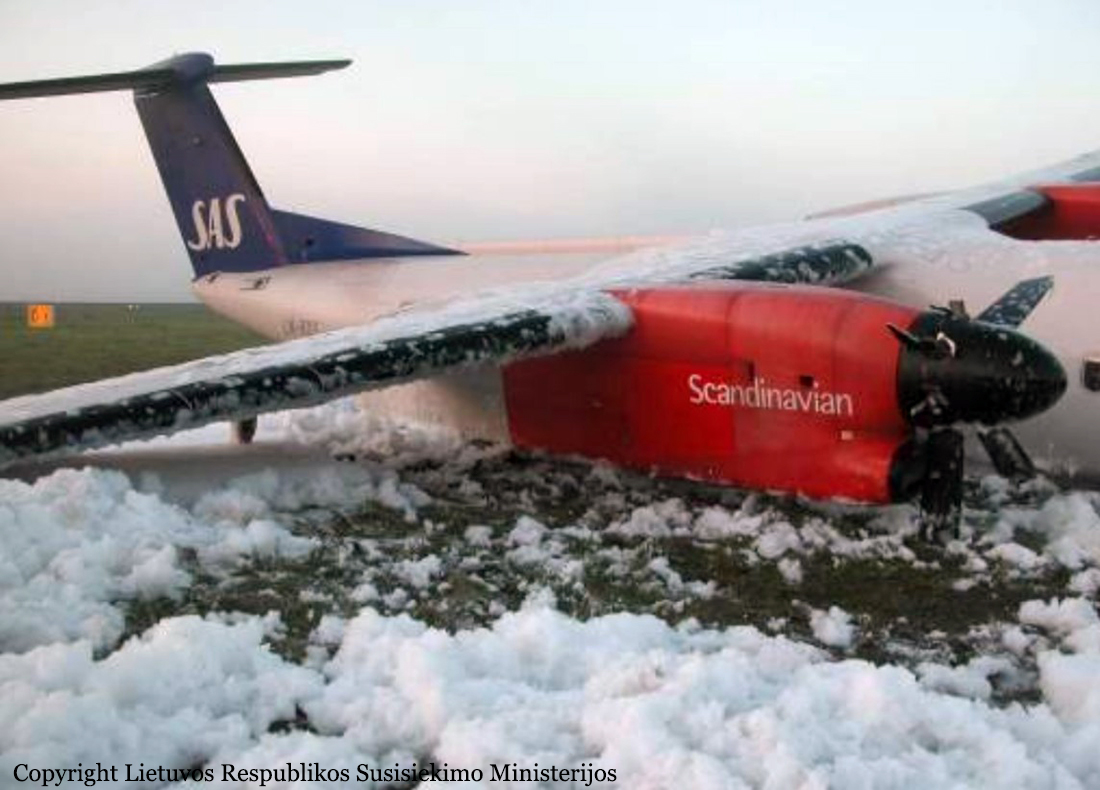




Crash of a De Havilland Dash-8-Q402 in Aalborg
Date & Time:
Sep 9, 2007 at 1557 LT
Registration:
LN-RDK
Survivors:
Yes
Schedule:
Copenhagen - Aalborg
MSN:
4025
YOM:
2000
Flight number:
SK1209
Crew on board:
4
Crew fatalities:
Pax on board:
69
Pax fatalities:
Other fatalities:
Total fatalities:
0
Captain / Total hours on type:
1000.00
Copilot / Total hours on type:
1085
Aircraft flight hours:
12141
Aircraft flight cycles:
14795
Circumstances:
The accident flight was a scheduled domestic flight from Copenhagen Airport, Kastrup (EKCH) to Aalborg Airport (EKYT). The flight was uneventful until the landing gear was selected down during the approach to EKYT runway 26R. The nose landing gear and the left main landing gear (MLG) indicated down and locked. The right MLG indicated “in transit” (not down and locked). The Aalborg Tower was informed about the problem with the right MLG indication. A go-around was initiated at 1100 feet MSL with a climb towards 2000 ft. The flight crew consulted the Quick Reference Handbook (QRH). An alternate landing gear procedure was initiated. The right MLG indication remained in “transit”. A mayday call was made to Aalborg Tower and they were informed about the unsafe landing gear. The flight crew reset the alternate gear extension system and subsequently they tried to make a normal gear up selection. The nose landing gear and the left MLG retracted normally, however the right main landing gear indication remained in “transit”. A second attempt to use the alternate landing gear extension procedure was performed without any changes to the right MLG indication. The aircraft entered a holding pattern in order to reduce the amount of fuel and at the same time to brief the passengers about the situation and to prepare the passengers for an emergency landing. Passengers seated at rows 6, 7 and 8 seats D and F were reseated away from the right propeller area. During the approach the flaps were selected to 10° and the landing gear horn started. The warning horn continued throughout the remaining flight. During the emergency landing the left MLG touched down on the runway first, followed by the right MLG. Shortly after the right MLG contacted the runway the right MLG collapsed. The aircraft departed the runway to the right and came to rest on a heading of 340° at 1357:26 hrs.
Probable cause:
There were five factors’ leading to the accident:
1. There were no specified inspection tasks for inspection of the MLG retraction/extension actuator and rod end either in the MRB’s report or in the Maintenance Requirement Manual in so far as “L”, “A” and “C” checks.
2. The right and left MLG retraction/extension actuator piston and rod end were made of noble martensitic stainless steel and the less noble 4340 steel material, respectively.
3. Severe corrosion in the threaded connection between the right MLG actuator rod and rod end.
4. Separation of the right MLG retraction/extension actuator from the actuator piston rod end.
5. The right MLG stabilizer joint lugs failed.
1. There were no specified inspection tasks for inspection of the MLG retraction/extension actuator and rod end either in the MRB’s report or in the Maintenance Requirement Manual in so far as “L”, “A” and “C” checks.
2. The right and left MLG retraction/extension actuator piston and rod end were made of noble martensitic stainless steel and the less noble 4340 steel material, respectively.
3. Severe corrosion in the threaded connection between the right MLG actuator rod and rod end.
4. Separation of the right MLG retraction/extension actuator from the actuator piston rod end.
5. The right MLG stabilizer joint lugs failed.
Final Report:



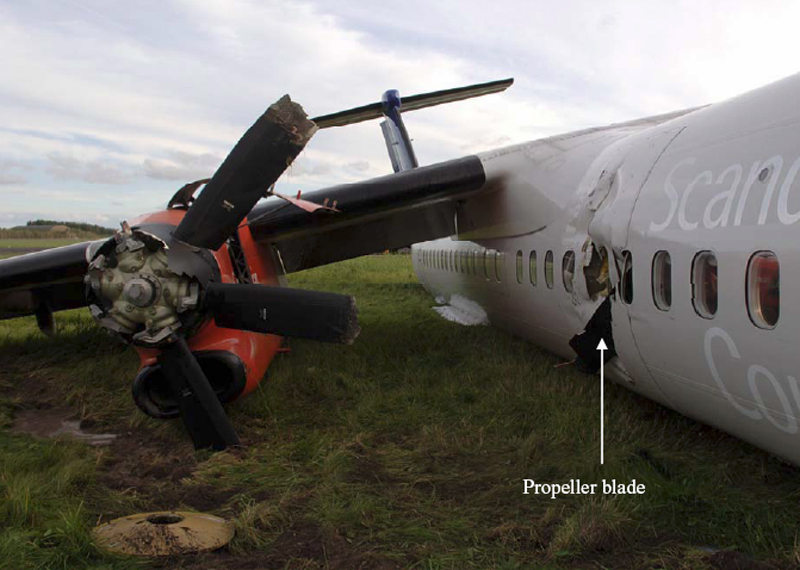
Crash of a De Havilland Dash-8-Q402 in Busan
Date & Time:
Aug 12, 2007 at 0938 LT
Registration:
HL5256
Survivors:
Yes
Schedule:
Jeju - Busan
MSN:
4141
YOM:
2006
Flight number:
JJA502
Crew on board:
5
Crew fatalities:
Pax on board:
74
Pax fatalities:
Other fatalities:
Total fatalities:
0
Aircraft flight hours:
1645
Aircraft flight cycles:
1876
Circumstances:
On 12 August 2007, about 05:20, the flight crew showed up and prepared for the flight of Gimpo/Jeju/Gimhae/Gimpo at the crew lounge of the Gimpo Airport. For a flight duty of the flight 103 (Gimpo to Jeju section), the flight crew departed from the Gimpo Airport at about 06:50 and arrived at the Jeju Airport at about 08:15. For the flight 502 (Jeju to Gimhae section), they departed the Jeju Airport at 08:49. While the aircraft passing through an altitude of 9,500 feet), RUD CTRL caution lights and #2 RUD HYD caution lights illuminated. Accordingly, the pilots followed and carried out the procedures) of QRH (Quick Reference Handbook). Referring to the pilots’ statements, #2 RUD HYD caution lights illuminated constantly during the flight; however, RUD CTRL caution lights illuminated intermittently. As it reached a cruising altitude of 15,000 feet, the pilots notified the condition of malfunctions and actions taken according to the QRH to a mechanic stationed at the Gimhae Airport. The pilots received a clearance from the Gimhae Approach Control for ILS RWY 36L then circling approach to RWY 18R. At the final approach course of ILS DME RWY 36L, after visually identifying the runway, the captain received a clearance for conducting a circling approach on initial contact with the Gimhae Control Tower. Referring to the pilots’ statements and the data of Flight Data Recorder (hereinafter referred to as "FDR"), from 09:33:57 until 09:34:03 (for the time of turning from the final approach course of ILS to enter a downwind for circling approach), the caution lights of Elevator Feel, RUD CTRL, Pitch Trim and other warning lights illuminated on the caution and warning lights panel. However, the pilots stated that they couldn’t recall all the caution lights illuminated at the time, and did not take any measures considering the illuminating lights as "nuisance.") The first officer who was a pilot flying continued the circling approach, and aligned his aircraft with the runway 18R on the final approach course. After aligned with runway 18R, the aircraft heading was at 178 degrees magnetic. At that time, according to the ATIS information, the wind direction/speed was 130 degrees at 13 knots gusting to 18 knots, ceiling 4,000 feet, and it was mostly cloudy. According to FDR record, at 09:38:08, about 2 feet above the runway, the rudder started to be applied to the right side. Concurrently, the pilot moved the control wheel to the right. At that time, the aircraft heading changed from 174 degrees to 175 degrees. At 09:38:09, the main landing gear of the aircraft touched down on the runway, and the aircraft heading was at 174 degrees. From the point where the main landing gear touched down, the aircraft continued to drift left into the wind. Initially the pilots applied right rudder in an attempt to maintain runway center-line. Rather then apply left wing down, the control wheel input was toward the right. According to the Cockpit Voice Recorder (hereinafter referred to as "CVR"), at 09:38:11, as the captain kicked onto the rudder pedal and said, "Why, why, Ah?" and the first officer replied, "it doesn’t respond.") At 09:38:13, the nose landing gear touched down, and the pilots started to apply brakes. At 09:38:15, all of sudden, the deceleration rate dropped. According to the tire marks, the aircraft departed the left edge of the runway at 3,500 feet from the end of runway. At 09:38:19, the groaning sound of one of the pilots, "Uh. Uh" was recorded on CVR. After 09:38:15, the heading direction of the aircraft was increasing to the left. According to CVR, at 09:38:25, there was a recorded voice of the captain, "Oh, no, Gosh,"and then at 09:38:27, with a sound of crash, the captain’s screaming sound, "Ah!" was recorded. The aircraft collided into a concrete drainage ditch, which is located 340 feet away from the centerline of the runway 18R and 4,600 feet away from the end of runway, and then it came to rest. When the aircraft stopped in the concrete drainage ditch, the pilots shut off the right engine, declared emergency to the air traffic control tower, and instructed the passengers to perform emergency evacuation.
Probable cause:
The Aviation and Railway Accident Investigation Board determines that the cause of the runway excursion of the Flight 502 was that the rudder failure was not recognized by the pilots during flight and as well as during landing roll. Contributing to this accident was that:
1) the rudder was failing to respond to the pilots' rudder pedal input and
2) After departing from the runway, no appropriate alternative measure was taken to control the aircraft direction.
1) the rudder was failing to respond to the pilots' rudder pedal input and
2) After departing from the runway, no appropriate alternative measure was taken to control the aircraft direction.
Final Report:
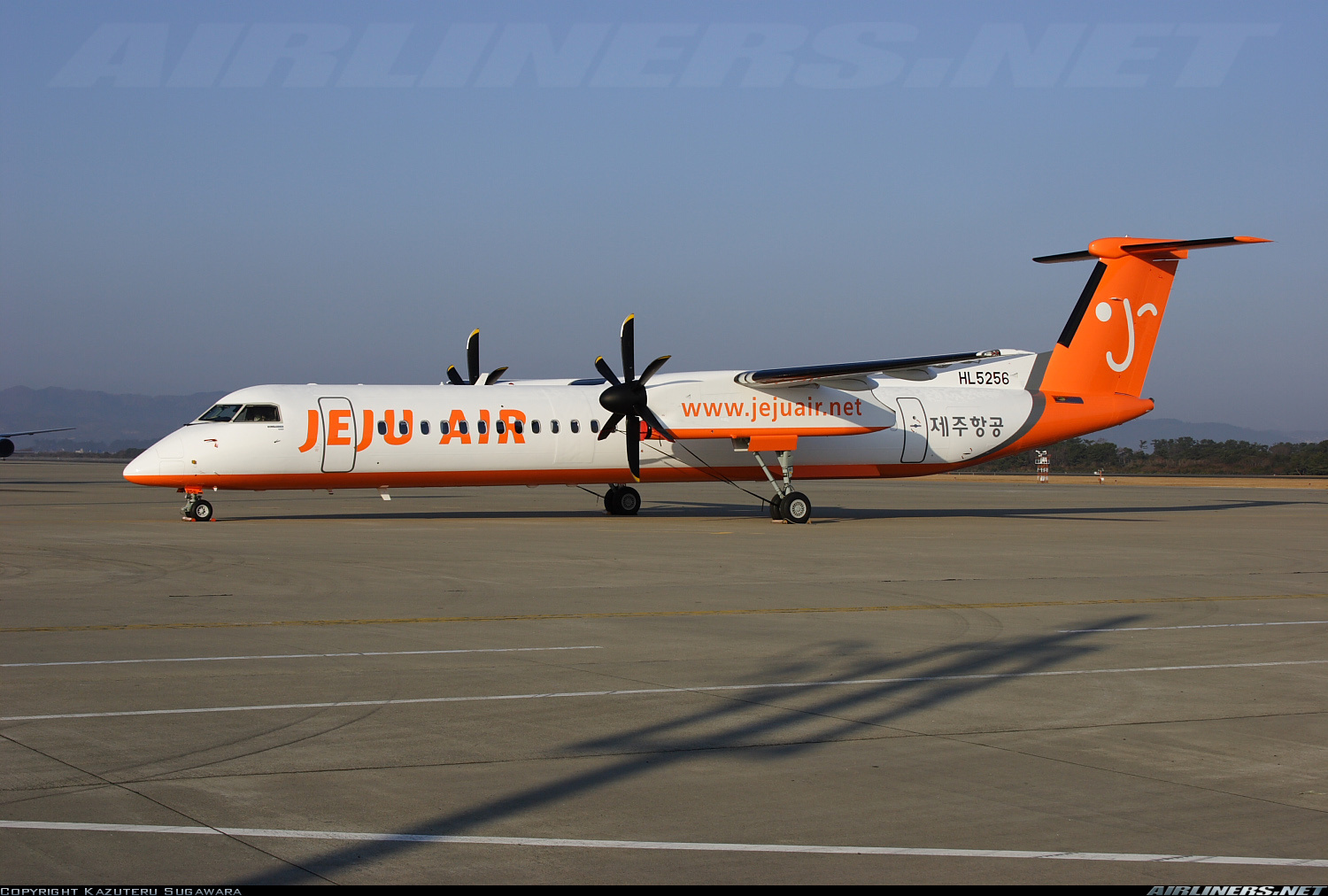
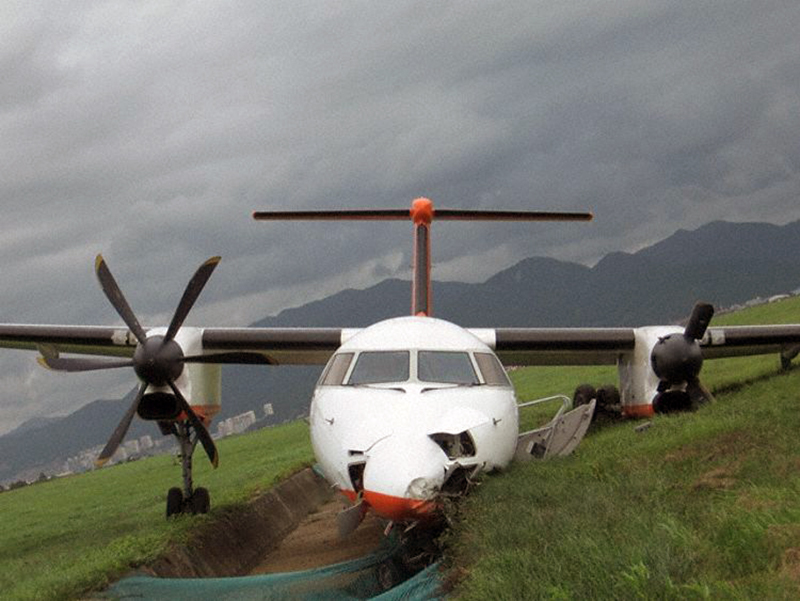
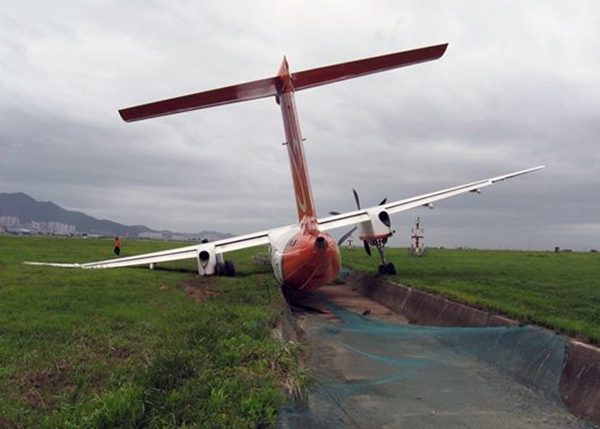

Ground accident of a De Havilland DHC-8-402Q Dash-8 in Xi'an
Date & Time:
Dec 7, 2002
Registration:
B-3567
Survivors:
Yes
MSN:
4005
YOM:
2000
Crew on board:
2
Crew fatalities:
Pax on board:
0
Pax fatalities:
Other fatalities:
Total fatalities:
0
Circumstances:
Two engineers took over the airplane for an engine test run at Xi'an Airport. While parked on the apron, the aircraft started to roll on a slippery ground and eventually collided with the main terminal. Both occupants escaped uninjured while the aircraft was damaged beyond repair. It was reported that snow fell during the preceding days and that the tarmac was slippery.
